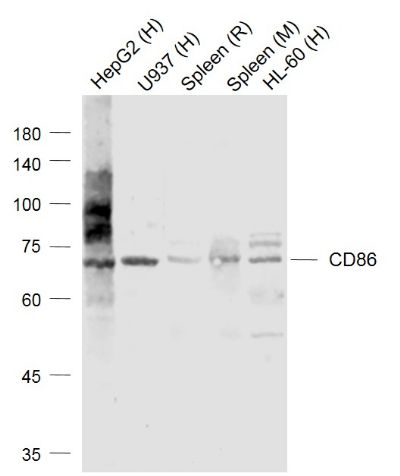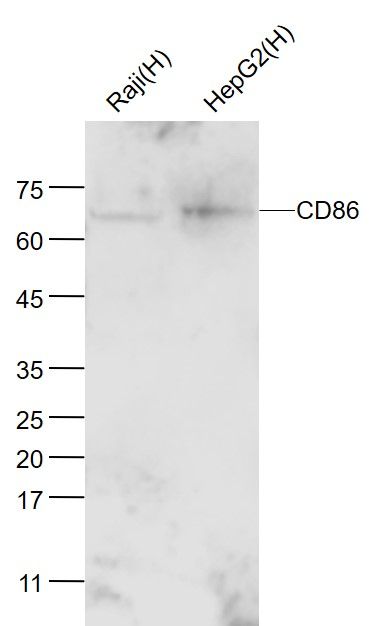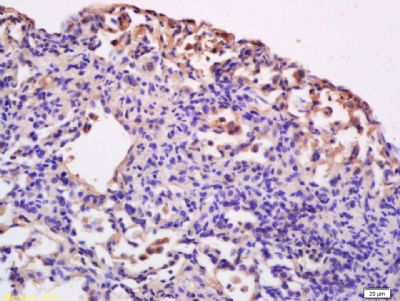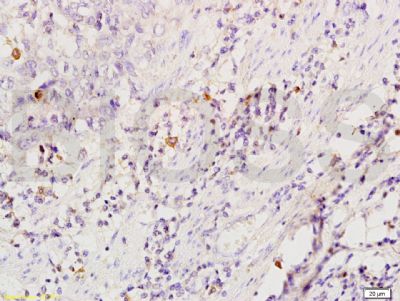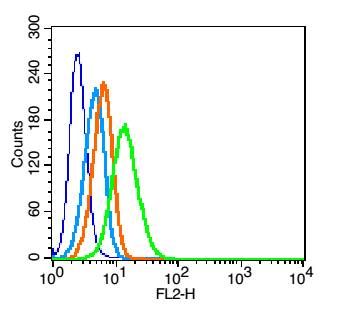[IF=14.593] Bin Wang. et al. Targeted delivery of a STING agonist to brain tumors using bioengineered protein nanoparticles for enhanced immunotherapy. Bioact Mater. 2022 Mar;: IF ; Mouse.
[IF=7.367] Yitian Du. et al. Engineered Microglia Potentiate the Action of Drugs against Glioma Through Extracellular Vesicles and Tunneling Nanotubes. 2021 Feb 28 IF,IHC ; Mouse.
[IF=20.722] Meng Lin. et al. CRISPR-based in situ engineering tumor cells to reprogram macrophages for effective cancer immunotherapy. Nano Today. 2022 Feb;42:101359 IF ; Mouse.
[IF=14.919] Singh, Alok Kumar. et al. Re-engineered BCG overexpressing cyclic di-AMP augments trained immunity and exhibits improved efficacy against bladder cancer. Nat Commun. 2022 Feb;13(1):1-16 IHC ; Mouse.
[IF=8.897] Liu, Houli. et al. Immunomodulatory hybrid bio-nanovesicle for self-promoted photodynamic therapy. Nano Res. 2022 Feb;:1-10 WB ; Mouse.
[IF=6.986] Dai Shi. et al. Synthesis and Evaluation of 68Ga-NOTA-COG1410 Targeting to TREM2 of TAMs as a Specific PET Probe for Digestive Tumor Diagnosis. Anal Chem. 2022;94(9):3819–3830 ICC ; Human.
[IF=6.922] Shanping Wang. et al. Isosteviol Sodium Exerts Anti-Colitic Effects on BALB/c Mice with Dextran Sodium Sulfate-Induced Colitis Through Metabolic Reprogramming and Immune Response Modulation. J Inflamm Res. 2021; 14: 7107–7130 IF ; Mouse.
[IF=4.932] Xueli Bai. et al. Regulatory role of methionine enkephalin in myeloid-derived suppressor cells and macrophages in human cutaneous squamous cell carcinoma. Int Immunopharmacol. 2021 Oct;99:107996 IF ; Mouse.
[IF=7.242] Tong Shen. et al. Sulfated chitosan rescues dysfunctional macrophages and accelerates wound healing in diabetic mice. Acta Biomater. 2020 Nov;117:192 IF ; Mouse.
[IF=4.546] Yahima Frión-Herreraet al. Cuban Brown Propolis Interferes in the Crosstalk between Colorectal Cancer Cells and M2 Macrophages. Nutrients
. 2020 Jul 9;12(7):2040. IF ; Human.
[IF=10.317] Yang G et al. A multifunctional anti-inflammatory drug that can specifically target activated macrophages, massively deplete intracellular H2O2, and produce large amounts CO for a highly efficient treatment of osteoarthritis. Biomaterials. 2020 Oct;255:120155. ICF ; Mouse.
[IF=4.708] Jiang L et al. Sonodynamic Therapy in Atherosclerosis by Curcumin Nanosuspensions: Preparation design, Efficacy Evaluation, and Mechanisms Analysis. Eur J Pharm Biopharm. 2020 Jan;146:101-110. IHSLCP ; Mouse.
[IF=3.118] Yu S et al. Dendritic cells modified with Der p1 antigen as a therapeutic potential for allergic rhinitis in a murine model via regulatory effects on IL-4, IL-10 and IL-13.Int Immunopharmacol. 2019 May;70:216-224. ICF ; Mouse.
[IF=5.554] Okonogi N et al. Combination therapy of intravenously injected microglia and radiotherapy prolongs survival in a rat model of spontaneous malignant glioma.International Journal of Radiation Oncology*Biology*Physics. 2018. IHSLCP ; Rat.
[IF=2.485] Ju et al. An effective cytokine adjuvant vaccine induces autologous T-cell response against colon cancer in an animal model. (2016) BMC.Immunol. 17:31 IHSLCP ; Mouse.
[IF=3.339] Matsui et al. M1 Macrophages Are Predominantly Recruited to the Major Pelvic Ganglion of the Rat Following Cavernous Nerve Injury. (2017) J.Sex.Med. 14:187-195 IHC ; rat.
[IF=4.26] Chen et al. Mesenchymal stem cell-laden anti-inflammatory hydrogel enhances diabetic wound healing. (2015) Sci.Re. 5:18104 IHSLCP ; Mouse.
[IF=2.829] Chen, Xionglin, et al. "Peptide-modified chitosan hydrogels promote skin wound healing by enhancing wound angiogenesis and inhibiting inflammation." Am J Transl Res 9.5 (2017): 2352-2362. IHSLCP ; Mouse.
[IF=1.48] Zhang, Suxin, et al. "Variation and significance of secretory immunoglobulin A, interleukin 6 and dendritic cells in oral cancer." Oncology Letters. IHSLCP ; Human.
[IF=5.76] Das, Subhamoy, et al. "Syndesome Therapeutics for Enhancing Diabetic Wound Healing." Advanced Healthcare Materials (2016). IHSLCP ; Mouse.
[IF=1.55] Chen, Quan, et al. "Prevention of ultraviolet radiation‑induced immunosuppression by sunscreen in Candida albicans‑induced delayed‑type hypersensitivity." Molecular Medicine Reports (2016). WB ; Mouse.
[IF=6.66] Evans, Elizabeth E., et al. "Antibody blockade of semaphorin 4D promotes immune infiltration into tumor and enhances response to other immunomodulatory therapies." Cancer Immunology Research (2015): canimm-0171. IHSLCP ; Mouse.
[IF=10.317] Yang G et al. A multifunctional anti-inflammatory drug that can specifically target activated macrophages, massively deplete intracellular H 2 O 2, and produce large amounts CO for a highly efficient treatment of osteoarthritis. Biomaterials
. 2020 Oct;255:120155. ICF ; Mouse.
[IF=5.411] Jiyuan Piao. et al. Substance P blocks β-aminopropionitrile-induced aortic injury through modulation of M2 monocyte-skewed monocytopoiesis. Transl Res. 2021 Feb;228:76 IHC ; Rat.
[IF=5.085] Hu Lijun. et al. Fusobacterium nucleatum Facilitates M2 Macrophage Polarization and Colorectal Carcinoma Progression by Activating TLR4/NF-κB/S100A9 Cascade. Front Immunol. 2021 May;12:1944 WB ; Human.
[IF=6.543] Wang Shanping. et al. Isosteviol Sodium Ameliorates Dextran Sodium Sulfate-Induced Chronic Colitis through the Regulation of Metabolic Profiling, Macrophage Polarization, and NF-κB Pathway. Oxid Med Cell Longev. 2022;2022:4636618 IF ; Mouse.
[IF=5.59] Liu, Xiaoqin. et al. Mdivi-1 Modulates Macrophage/Microglial Polarization in Mice with EAE via the Inhibition of the TLR2/4-GSK3β-NF-κB Inflammatory Signaling Axis. 2021 Oct 07 IHC ; Mouse.
[IF=4.932] Shuling Zhang. et al. A novel mechanism of lung cancer inhibition by methionine enkephalin through remodeling the immune status of the tumor microenvironment. Int Immunopharmacol. 2021 Oct;99:107999 IF ; Mouse.
[IF=5.606] Luo Ping. et al. IL-37 inhibits M1-like macrophage activation to ameliorate temporomandibular joint inflammation through the NLRP3 pathway. Rheumatology. 2020 Oct;59(10):3070-3080 WB,IF ; Human.
[IF=4.238] Chi Ben. et al. Alternative splicing reverses the cell-intrinsic and cell-extrinsic pro-oncogenic potentials of YAP1. J Biol Chem. 2020 Oct;295:13965 IHC ;
[IF=8.352] Ye Hea et al. Improved osteointegration by SEW2871-encapsulated multilayers on micro-structured titanium via macrophages recruitment and immunomodulation. Applied Materials Today 20 (2020) 100673 IHC/IF ; Rat/Mouse.
[IF=2.876] Shi F et al. Heat injured stromal cells-derived exosomal EGFR enhances prostatic wound healing afterthulium laser resection through EMT and NF-κB signaling. Prostate. 2019 May 24. IHF ; Dog.
[IF=3.323] Breda PC et al. Renal proximal tubular epithelial cells exert immunomodulatory function by driving inflammatory CD4+ T-cell responses. Am J Physiol Renal Physiol. 2019 Apr 24. IHSLCP ; Human.
[IF=5.7] Peruzzaro ST et al. Transplantation of mesenchymal stem cells genetically engineered to overexpress interleukin-10promotes alternative inflammatory response in rat model of traumatic brain injury. J Neuroinflammation. 2019 Jan 5;16(1):2. IHC ; Rat.
[IF=3.585] Deng Z et al. M1 macrophage mediated increased reactive oxygen species (ROS) influence wound healing via the MAPK signaling in vitro and in vivo. Toxicol Appl Pharmacol. 2019 Mar 1;366:83-95. IHF ; Human.
[IF=3.427] Gao et al. Common expression of stemness molecular markers and early cardiac transcription factors in human Wharton's jelly-derived mesenchymal stem cells and embryonic stem cells. (2013) Cell.Transplan. 22:1883-900 FCM ; Human.
[IF=5.01] Gerzanich, Volodymyr, et al. "Salutary effects of glibenclamide during the chronic phase of murine experimental autoimmune encephalomyelitis." Journal of Neuroinflammation 14.1 (2017): 177. IHSLCP ; Mouse.
[IF=5.19] Han, Sheng, et al. "LPS alters the immuno-phenotype of glioma and glioma stem-like cells and induces in vivo antitumor immunity via TLR4." Journal of Experimental & Clinical Cancer Research 36.1 (2017): 83. WB ; Human.
[IF=1.58] Liang, Zhuoping, et al. "Role of dendritic cells in consistency between upper and lower airway inflammatory responses: animal experimental studies." Int J Clin Exp Pathol 9.10 (2016): 10093-10104. IHSLCP ; Rat.
[IF=0.9] Zhou, Xi-Jin, et al. "Vasoactive Intestinal Peptide Promotes Immune Escape of MKN45 Cells by Inhibiting Antigen-Presenting Molecules of Dendritic Cells In Vitro." International Journal of Peptide Research and Therapeutics: 1-13. other ;
[IF=2.96] Xie, Juan, et al. "PICK1 confers anti-inflammatory effects in acute liver injury via suppressing M1 macrophage polarization." Biochimie (2016). WB ; Mouse.
